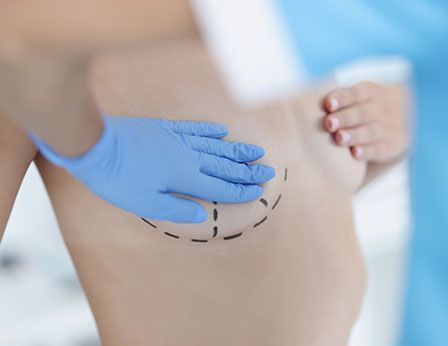Doctors specializing in
Breast Cancer and
Laparoscopic hysterectomy
We have the best Oncologists specializing in women's care.
Medical Trip Comprehensive Medical Tourism Services in Mexico is a company with different services focused on preserving women's health. We know that cancer in Mexico is a very serious illness that can physically and mentally exhaust the patient if timely care is not provided and that is why we offer you the best specialists in the field.
MASTECTOMY PACKAGE
- First assessment consultation with a certified specialist, free/virtual.
- Medical fees (complete medical team for the day of the intervention, surgeon, 2 surgical assistants, 1 surgical nurse, anesthesiologist, pathologist if required).
- Personalized advisor who will take care of all the logistics for your intervention.
- Necessary transport derived from and for your treatment.
- Laboratory and office examinations if necessary.
- One day of hospitalization.
- Reservation and use of surgical instruments, complete equipment, surgical and healing supplies during your hospitalization.
- Stay in recovery room, monitored.
- PCR test (Not included). It must be sent 72 hours before the procedure, it must be no more than 3 days.
- Personalized follow-up after surgery.
- Specialized instruments for carrying out the procedure.
Mastectomy
Mastectomy is a procedure by which breast cancer is treated through surgical removal.
Why is it done?
It is done to treat or prevent breast cancer. This operation is carried out preventively to treat people with high risk in their diagnosis.
It is also carried out when the person cannot undergo surgery to remove the cancerous tumor with breast conservation (lumpectomy) or when, for personal reasons, the person opts for a mastectomy after the diagnosis has been made.
-
WHAT IS A MASTECTOMY?
Through this procedure, breast tissue is removed when a diagnosis of cancer is found. Part of the skin and nipple can also be removed.
Who are candidates?
Care after a mastectomy
- People who cannot receive radiotherapy
- They prefer surgery to receiving radiotherapy
- People who received treatment in the breast with radiotherapy
- Had breast-conserving surgery, along with excision(s) that did not completely remove the cancer
- There are two or more areas of cancer in the region
- Has a tumor that measures more than 5 centimeters
- A pregnant woman who would need radiation therapy that could harm the fetus
- People suffering from inflammatory breast cancer
- You should try to have your arm raised while sitting.
- Try not to sleep on the side where you had surgery
- Avoid any type of effort on the operated side
- Take care of your skin and always keep it clean, the doctor will provide you with more information about it
- Avoid the application of irritants
- Use a bra with wide straps, avoiding pressure on the shoulder
- Swimming is recommended
What can I expect from this surgery?
What is breast cancer?
Recovery from this procedure can take 4 to 8 weeks. Stiffness may occur in the shoulder, chest and arm, which improves over time and can be relieved with physical therapy sessions.
After a mastectomy, it is also common for a woman to consider redoing the breast to restore its appearance, known as breast reconstruction.
Breast cancer is a disease in which cells in the breast multiply uncontrollably. There are different types of breast cancer. The type of breast cancer depends on which cells in the breast become cancerous.
Breast cancer can start in different parts of the breast. The breasts consist of three main parts: lobules, ducts and connective tissue. The lobules are the glands that produce milk. Ducts are the tubes that transport milk to the nipple.
Symptoms of breast cancer
Who can get breast cancer?
- Irritation or sinking in the skin of the breast.
- Sinking of the nipple or pain in that area.
- Redness or peeling in the nipple or breast area.
- Discharge from the nipple, other than milk, including blood.
- Any change in the size or shape of the breast.
- Pain in any part of the breast.
- A new lump in the breast or armpit (under the arm).
- Increase in thickness or swelling of a part of the breast.
There are different risk factors. Breast cancer is more common in women than in men and there are characteristics that can enhance it such as:
- Over 50 years of age
- Some type of genetic mutation
- Reproductive history
- Have dense breasts
- Personal history of breast cancer or non-cancerous breast diseases
- Family background
- Previous treatments with radiotherapy
What causes breast cancer?
How is it diagnosed?
Factors such as obesity, alcohol consumption, radiation exposure, family, reproductive and/or family history, and tobacco consumption are triggers for this condition.
There are different methods to detect breast cancer such as:
- Breast ultrasound
- Diagnostic mammography
- Magnetic resonance imaging (MRI) of the breasts
- Biopsy
Why is it done?
It is usually performed to permanently treat benign or malignant tumors in the uterus.
Laparoscopic Hysterectomy
What is laparoscopic hysterectomy?
With this procedure, partial or total removal of the uterus and affected adjacent tissues is carried out without the need to open the abdomen, which is also known as minimally invasive surgery.
What does it consist of?
3 to 5 incisions are made in the skin of the lower abdomen, through which the optical, electrocoagulation and special plier instruments are introduced throughout the abdomen to carry out the surgery. In this way, we work with an enlarged image in real time in the area, facilitating the degree of precision of the surgical procedure.
Benign
- Benign tumors in the wall of the uterus
- Endometriosis
- Urinary prolapse
- Uterine bleeding
Malignant
- Cancer of the uterus, cervix or ovary
Who are candidates for this procedure?
This surgery is indicated for patients who present pathologies such as:
What can I expect after this surgery?
Complete recovery after having a Laparoscopic Hysterectomy can take 4 to 6 weeks, with the first two weeks being the most complicated for the patient.
During the most difficult weeks, it is recommended to take painkillers that can relieve the discomfort.
Two weeks after surgery, the patient can carry out certain daily activities such as desk work or moderate walks. In terms of nutrition, it is recommended to consume smaller meals than normal and healthy snacks between said meals. It is also recommended to drink 2 liters of water a day and consume plenty of fruits and vegetables.
What care should I take after surgery?
If sutures, staples, or skin elastics were used in the procedure, you can remove the skin bandage and take a shower the day after surgery.
If surgical tapes were used, they usually come off on their own after a week.

-
Uterine cancer
Uterine cancer is located where a baby develops when a woman is pregnant. There are different types of this cancer, the most common being that of the endometrium, the membrane that lines the uterus.
-
Main symptoms of uterine cancer:
- Pelvic painBleedingAbnormal vaginal dischargeDifficulty urinatingPain during sexual intercourse
Tests to detect this type of cancer may include a pelvic exam, imaging tests, and biopsies. While the treatment of this disease is mainly based on performing a Hysterectomy, with which the uterus is removed.

-
Cervix cancer
Cervical cancer, also called cervical cancer, is a disease that originates in the cells that line the cervix, which is located in the lower part of the uterus. The cervix connects the body of the uterus (the upper part where the fetus develops) with the vagina (the canal through which the baby is born). Cancer starts when cells start out abnormally and out of control.
-
Main symptoms of cervical cancer
- Vaginal bleeding after sexual intercourse Vaginal bleeding after menopause Vaginal bleeding between menstrual periods or heavy and/or prolonged menstrual periods Pelvic pain or pain during sexual intercourse Strong-smelling or bloody liquid vaginal discharge.
-
There are three main tests to detect cervical cancer:
- Human Papillomavirus (HPV) Test. With this test, the cells are examined to find infections by some type of high-risk HPV that triggers cervical cancerPap smear test. Through this exam, cells are obtained from the cervix to analyze changes caused by HPV. Joint HPV and Pap smear test. A combination of the two previous tests.

-
Ovarian cancer
It is an abnormal and rapid growth of the cells that make up the ovaries. These multiply rapidly and can invade and destroy healthy tissues in the body.
-
Symptoms of ovarian cancer
- Abnormal vaginal bleeding or discharge Pain or pressure in the pelvic area Abdominal or back pain Feeling bloated Drastic changes in common habits such as going to the bathroom or a constant need to urinate, in addition to constipation problems.
-
There are two tests to detect ovarian cancer:
- Transvaginal ultrasound. Sound waves are used to examine the uterus, fallopian tubes, and ovaries to help find a tumor in the ovary. CA-125 blood test. This measures the amount of CA-125 protein in the blood. A woman with ovarian cancer has high levels of CA-125 protein in her blood, so this test may help.
LAPAROSCOPIC HYSTERECTOMY PACKAGE
- First assessment consultation with a certified specialist, free/virtual. Medical fees (complete medical team for the day of the intervention, surgeon, 2 surgical assistants, 1 surgical nurse, anesthesiologist, pathologist if required). Personalized advisor who will take care of all the logistics for your intervention. Necessary transportation to be provided derived from and for your treatment. Laboratory and cabinet examinations if necessary. One day of hospitalization. Reservation and use of surgical instruments, complete surgical and laparoscopy equipment and with appropriate instruments, surgical and healing supplies during your treatment. hospitalization.Stay in recovery room, monitored.PCR test (Not included). It must be sent 72 hours before the procedure, it must be no more than 3 days. Personalized follow-up after surgery. Specialized team to carry out the procedure.
This procedure is performed immediately after a mastectomy has been performed. When the breast is reconstructed at the same time as the mastectomy is performed (a technique called immediate reconstruction), the patient wakes up from the intervention with an adequate breast contour, avoiding the experience of seeing herself with an amputated breast.
Mastectomy with immediate reconstruction
Why is it done?
It is done to treat or prevent breast cancer. This operation is carried out preventively to treat people with high risk in their diagnosis.
However, the fact that an immediate breast reconstruction is performed produces a positive psychological effect on the patient, since the consequence of seeing herself with an amputated breast is avoided.

What does it consist of?
-
BREAST RECONSTRUCTION SURGERY AFTER MASTECTOMY
After a mastectomy, a woman may consider reshaping the breast to restore its appearance. This is known as breast reconstruction. Although each case is different, most patients who have had a mastectomy have the option of reconstruction. Reconstruction may be done at the same time as the mastectomy, or it may be done afterward.
-
BREAST RECONSTRUCTION WITH IMPLANTS
Implants are inserted under the skin or muscle of the chest after the mastectomy. (Most mastectomies are performed using a technique called skin-sparing mastectomy, in which most of the skin of the breast is saved for use in breast reconstruction.)
-
BREAST RECONSTRUCTION WITH TISSUE FROM THE WOMAN'S SAME BODY
In autogenous tissue reconstruction, a piece of tissue containing skin, fat, blood vessels, and sometimes muscle from somewhere else in the woman's body is used to reconstruct the breast. This piece of tissue is called a flap.
-
ABDOMINAL AND BACK FLAPS ARE:
Latissimus dorsi flap (LD): This is tissue that comes from the middle and side of the back. This type of flap is pedicled when used for breast reconstruction. (LD flaps can also be used for other types of reconstruction.)

-
HOW IS THE NIPPLE AND AREOLA RECONSTRUCTED?
After the breast heals from the reconstruction surgery the surgeon can reconstruct the nipple and areola. The new nipple is usually created by cutting and moving small pieces of breast skin that has been reconstructed to the nipple site, where they are shaped into a new nipple. A few months after nipple reconstruction, the surgeon can create the areola. This is usually done with tattoo ink. However, in some cases, skin grafts can be taken from the groin or abdomen and attached to the breast to create an areola when the nipple is reconstructed.
-
Who are candidates?
Almost any woman who has had a mastectomy can apply for breast reconstruction.
-
What to expect from a mastectomy with immediate reconstruction?
After the procedure, it is very common for bruising or scars to appear. If implants were used, there may be the case of suffering a muscle contracture that will cause the reconstructed breast to have a harder texture than usual. This can be combated with breast massages or surgery. Most women start to feel better after a couple of weeks and can return to normal activities after a couple of months.
-
What care should I take after surgery?
When you leave the hospital, you may be given drains or small tubes that are placed in the wound and remove unnecessary fluid from the surgery site. Your doctor will tell you when to remove these drains.
MASTECTOMY PACKAGE WITH IMMEDIATE RECONSTRUCTION
- First assessment consultation with a certified specialist, free/virtual. Medical fees (complete medical team for the day of the intervention, 1 gynecological oncology surgeon, 2 surgical assistants, 1 reconstruction surgeon, 1 surgical nurse, anesthesiologist, pathologist if required). Breast implant or breast expander if necessary .Personalized advisor who will be in charge of all the logistics for your intervention.Necessary transportation arising from and for your treatment.Laboratory and cabinet examinations if necessary.One day of hospitalization.Reservation and use of operating room surgical instruments, complete equipment, surgical and healing supplies during your hospitalization. Stay in a recovery room, monitored. PCR test (Not included). It must be sent 72 hours before the procedure, it must be no more than 3 days. Personalized follow-up after surgery. Specialized instruments for carrying out the procedure.
USO OF COOKIES AND WEB BEACONS
Medical Trip informs you that our website uses its own or third-party cookies and/or web beacons to improve your experience on the site, storing your preferences and personalizing content and advertising. To disable the operation of cookies and other website data, as well as to learn about the processing of your data and information, visit our
NOTICE OF PRIVACY
Engage ---



